This post may contain affiliate links. Please see our disclosure policy.
Watermelon jelly is made with the juice of ripe, juicy watermelon, and this vibrant homemade jelly will bring the sunny taste of summer to the table all year long.
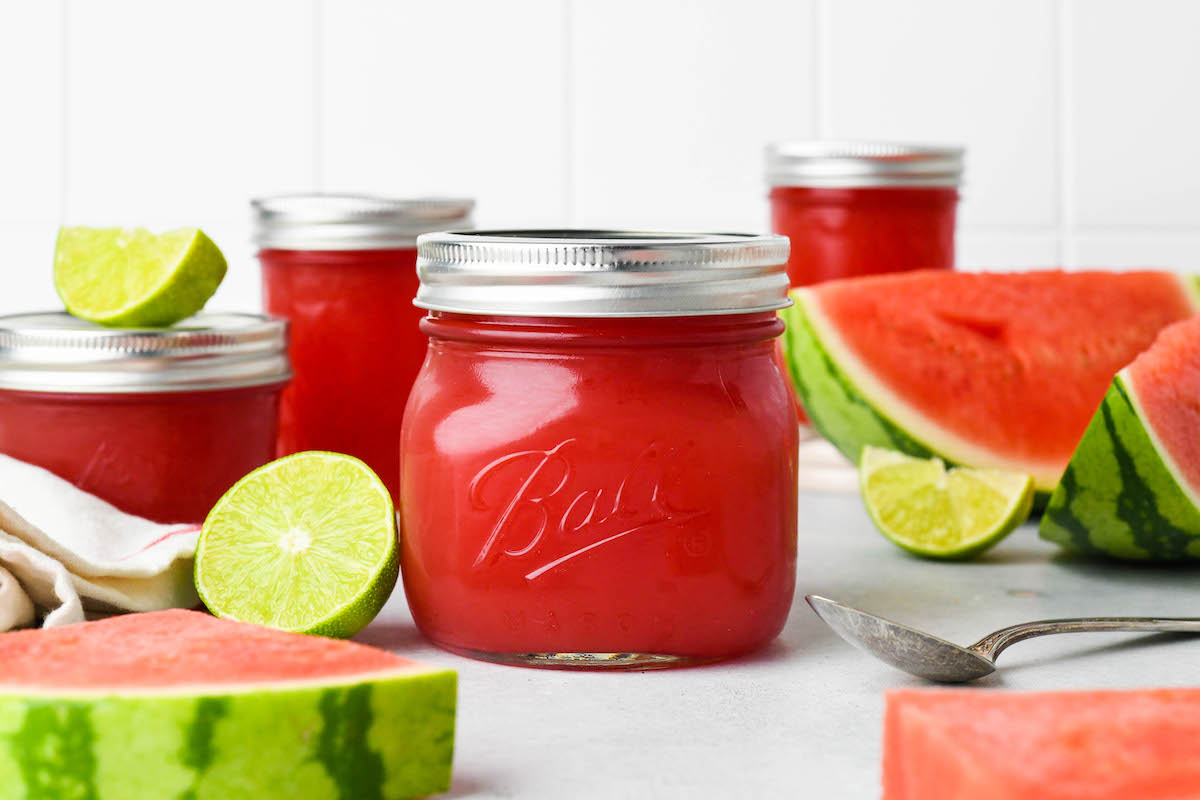
While you’re less likely to find watermelon jelly on the shelves at most grocery stores, this sweet preserve is one the tastiest (not to mention the most unique) jellies I’ve ever had the pleasure of tasting. Imagine all the wonderful flavors of a vine-ripened watermelon concentrated into an almost shockingly pink jelly, used to spread on your morning toast or as a topper for creamy homemade ice cream.
Watermelon isn’t quite acidic enough for canning alone, but I’ve added enough citrus juice to balance the jelly flavor-wise and ensure safe canning.
Most of the recipes I’ve come across for watermelon jelly use lemon juice as an acid, but I’ve opted for lime juice in my version. If you’ve ever enjoyed fresh watermelon juice with a spritz of lime juice (and maybe a splash of vodka), then you know where I’m coming from.

Watermelon jelly makes a gorgeous gift, too, especially during the cold winter months, when ripe watermelon seems like an impossibility or, at the very least, a treat that’s far, far off in the distance. I mean, flowers and wine are always a lovely hostess gift, but a ribbon-wrapped half-pint of watermelon jelly is like bringing the summer directly into someone’s home when it’s most needed.
The best part about this recipe for watermelon jelly?
It’s super easy, requires only four ingredients, and allows you to opt out of canning altogether if you’d rather make a refrigerator or freezer preserve.
But I urge you, for the sake of your sun-starved selves during the cold and dark months of winter, to can at least one or two jars of the stuff—your future self will thank you!

A Quick Look at the Recipe
- Recipe Name: Watermelon Jelly
- Recipe Type: Jelly Recipe
- Canning Method: Waterbath Canning
- Prep/Cook Time: 30 Minutes
- Canning Time: 10 Minutes
- Yield: 4 to 5 half pint jars
- Jar Sizes: Quarter Pint, Half Pint or Pint
- Headspace: 1/4 inch
- Ingredients Overview: Watermelon Juice, Lemon Juice (not optional), sugar and pectin
- Difficulty: Easy! Once you have the juice it’s quickly set with pectin without much fuss.
- Similar Recipes: The process is very similar to making other old fashioned summertime fruit jellies with added pectin, including Cherry Jelly, Peach Jelly, Elderberry Jelly and Corn Cob Jelly.
Is Watermelon Safe For Canning?
Watermelon has an average pH of around 5.2 to 5.6, which is not acidic enough for safe canning. Fruits must be below a pH of 4.6 to be safe for canning, which is a good bit more acidic than plain watermelon.
Safe Watermelon canning recipes have quite a bit of added acid, either in the form of lemon juice or vinegar. To make this recipe safe for canning, you need to add quite a bit of citrus juice, either lemon or lime.
Adding 1/2 cup of bottled lemon or lime juice is sufficient to drop the pH for canning.
Even if you’re not canning, it’s a good idea to add citrus juice because it helps to balance out the sugar in this recipe. Watermelon jelly can be a bit insipid on its own, and really does need that acidity to add tartness so that everything tastes right.
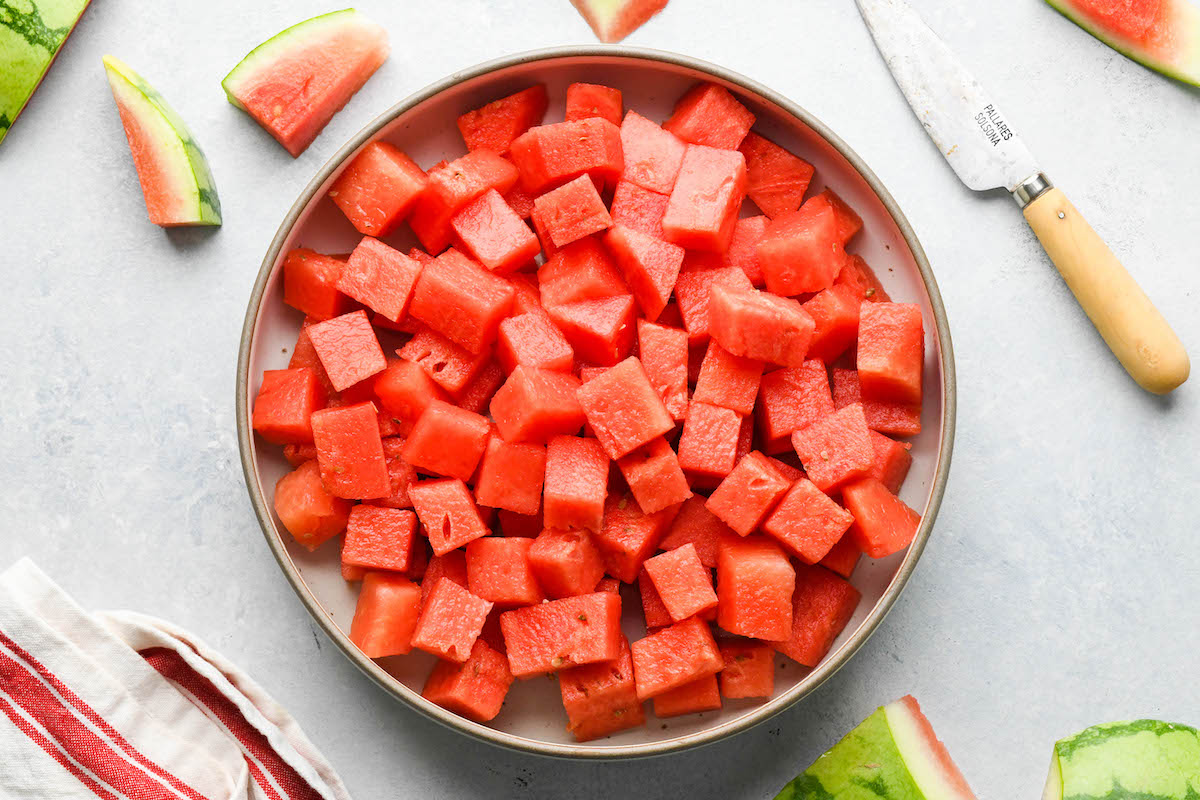
Ingredients for Watermelon Jelly
The ingredient list for watermelon jelly is short, with juicy, ripe watermelon being the main ingredient!
You could also try making this jelly with a yellow watermelon-adjacent variety of melon, such as a Yellow Crimson or a Yellow Doll. Because yellow melons tend to be sweeter than most types of watermelon, you can decrease the amount of sugar called for in the recipe.
- Watermelon: For this recipe, you’ll need about 6 to 8 cups of chopped watermelon with the rind removed (or the equivalent of one small-ish watermelon)—the goal is 4 cups of watermelon juice.
- White granulated sugar ~The amount will depend on how sweet you like your watermelon jelly. Anywhere between 1 cup and 4 cups works well, see notes.
- Lime juice ~ Bottled rather than fresh, and I recommend using Santa Cruz organic or Lakewood organic. Their flavor is better, and they don’t have other additives or preservatives like some brands.
- Sure Jell low sugar pectin*
*Low-sugar pectin will allow you to use less sugar (if you prefer a less sweet jelly) without affecting the jelly’s ability to set. In general, I find Sure Jell low-sugar pectin to be the most fail-proof for home canning projects.

How to Make Watermelon Jelly
To make this watermelon jelly recipe, you’ll need about 6 to 8 cups of chopped watermelon, which should be the yield from one smallish watermelon.
To remove the rind and prep the watermelon quickly, slice off both ends of the melon, set it on one of the flat ends, and then use a sharp knife to shave the rind off from tip to tail—you’ll be left with intact watermelon flesh that just needs to be chopped into small pieces.
You can save your leftover watermelon rinds for making either old fashioned watermelon rind pickles or watermelon rind preserves.
Don’t worry about seeds, we’re going to be pushing the watermelon through a cheesecloth or a jelly bag to strain out any clumps or bits of seed before we make the jelly.
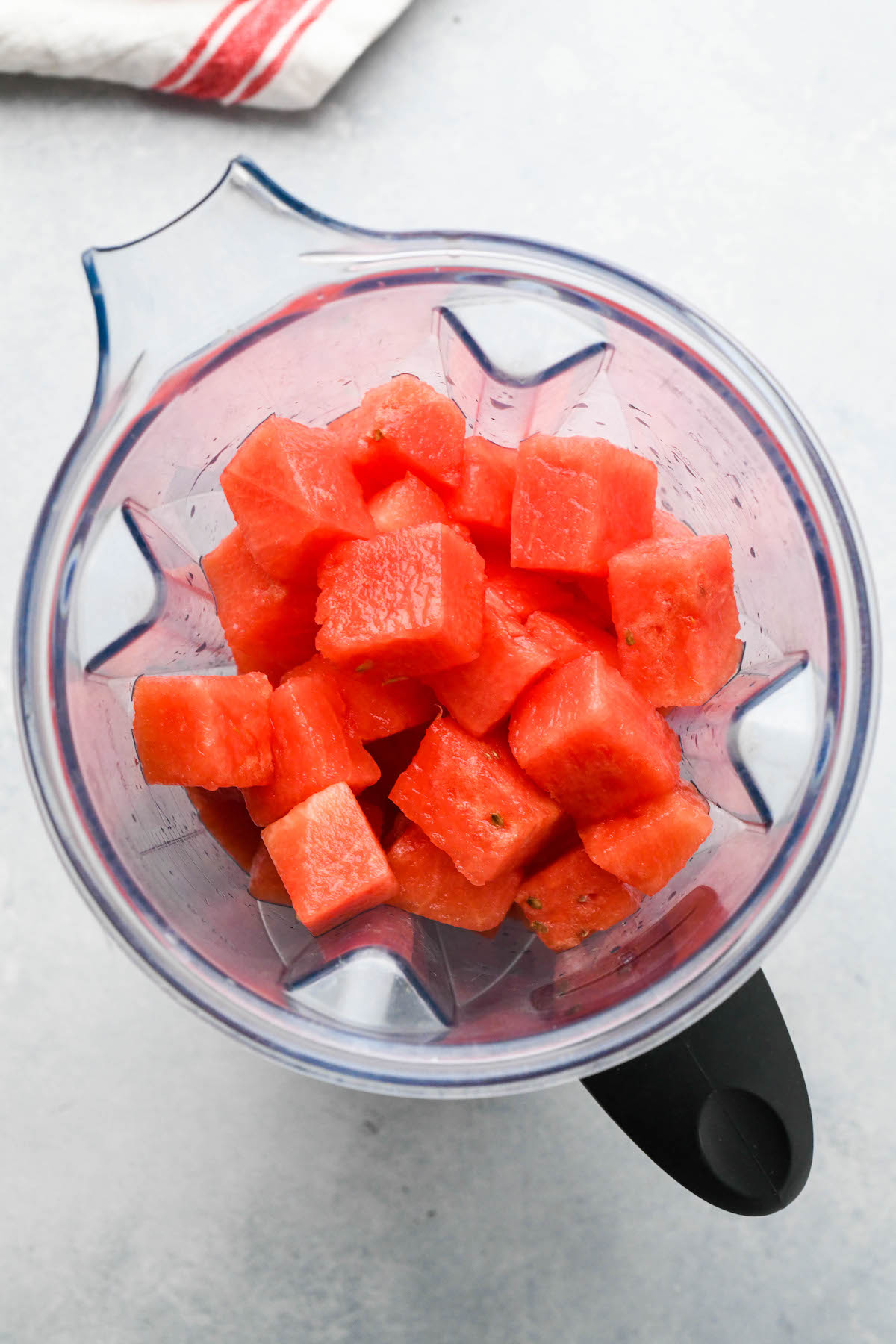
Add the chopped watermelon to a blender and purée until the fruit is blended and smooth. If you have a smaller blender jar, work in batches to prevent accidental overflow during the blitzing process.
Line a fine mesh sieve with a folded strip of cheesecloth or a jelly strainer bag and place it over a large bowl or measuring cup with a lip. Pour the puréed watermelon through the lined strainer, using a wooden spoon or spatula to press the leftover watermelon pulp to extract the juice.
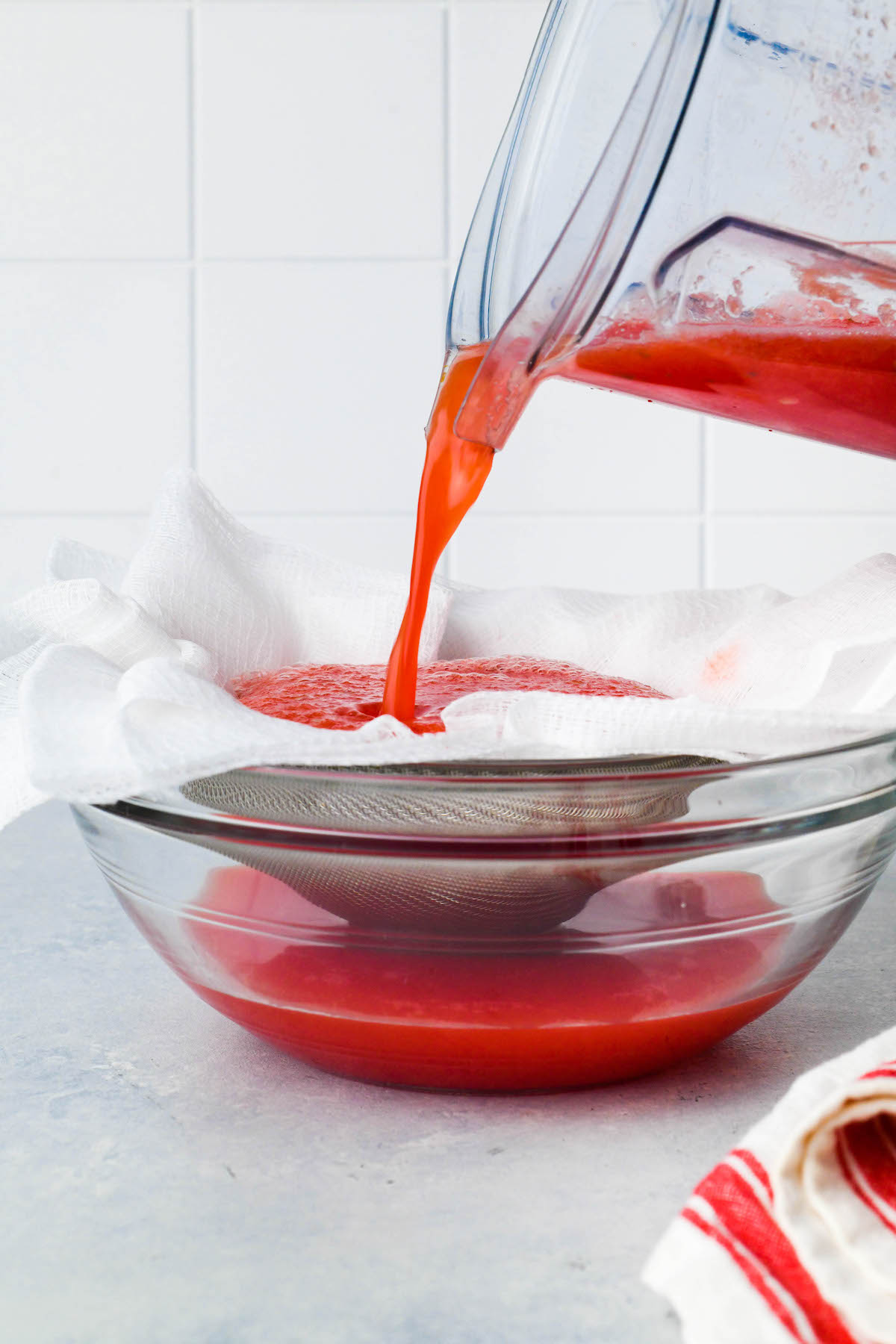
Measure out 4 cups of extracted watermelon juice (enjoy any remaining juice with a bit of fresh lime for a refreshing beverage, or can it up as a watermelon lemonade concentrate). Add the juice to a saucepan along with 1/2 cup of bottled lime juice and stir to combine.
Next, stir in one package of Sure Jell low-sugar pectin, whisking to dissolve. Do not add the sugar at this point; if the sugar is added early, the jelly won’t set.
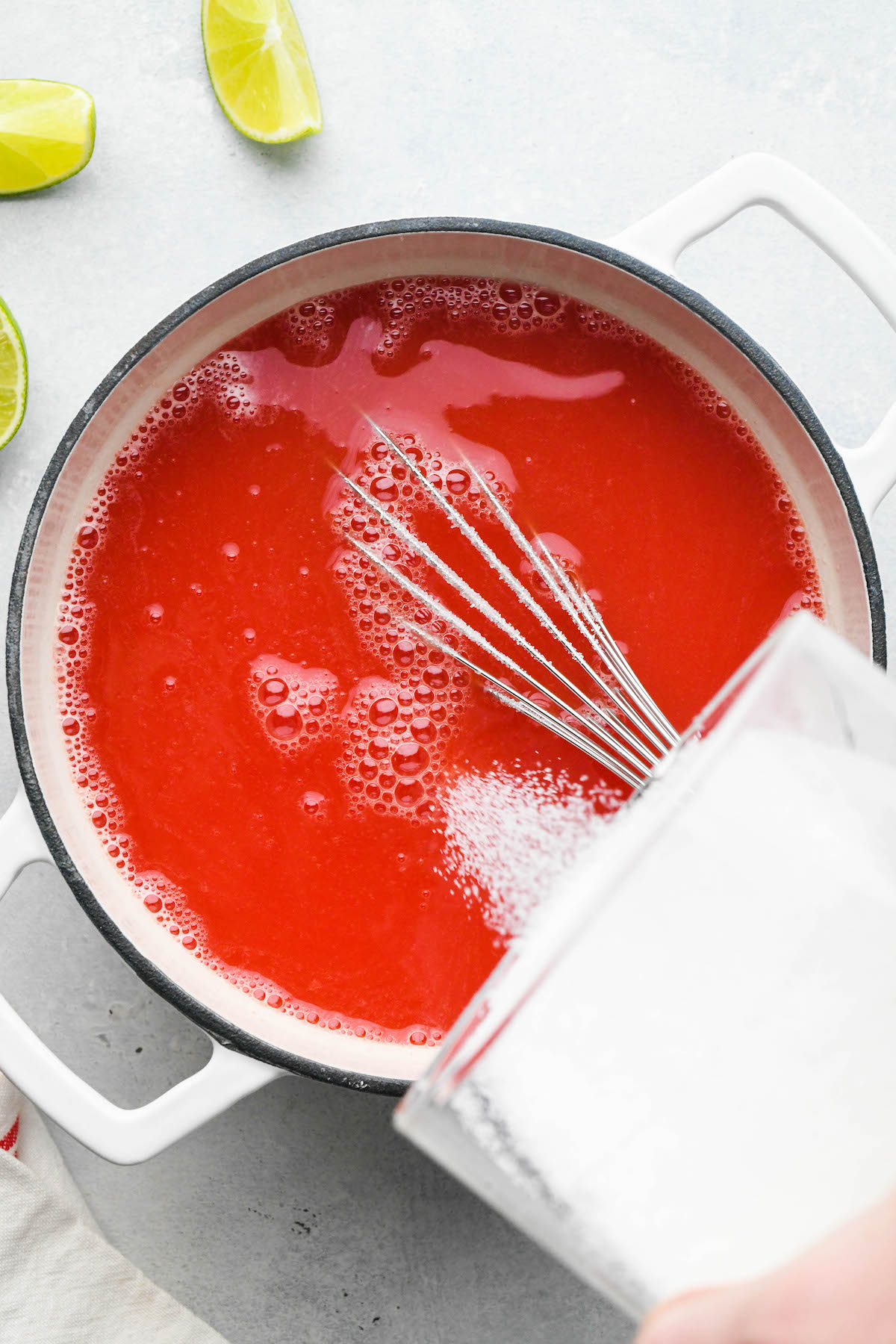
Bring the watermelon juice, lime juice, and low-sugar pectin to a boil. Set the timer for one minute, and boil the ingredients. After a full minute has gone by, now it’s time to add the sugar.
The amount of sugar you’ll add will depend on how sweet you prefer your fruit jellies as well as the sweetness of the actual watermelon.
As a general guideline, I recommend adding between 2 and 3 cups of white granulated sugar. Whatever amount you choose, whisk it into the watermelon juice mixture to dissolve, set the timer for one minute, and then repeat the timed boiling step from above once more.
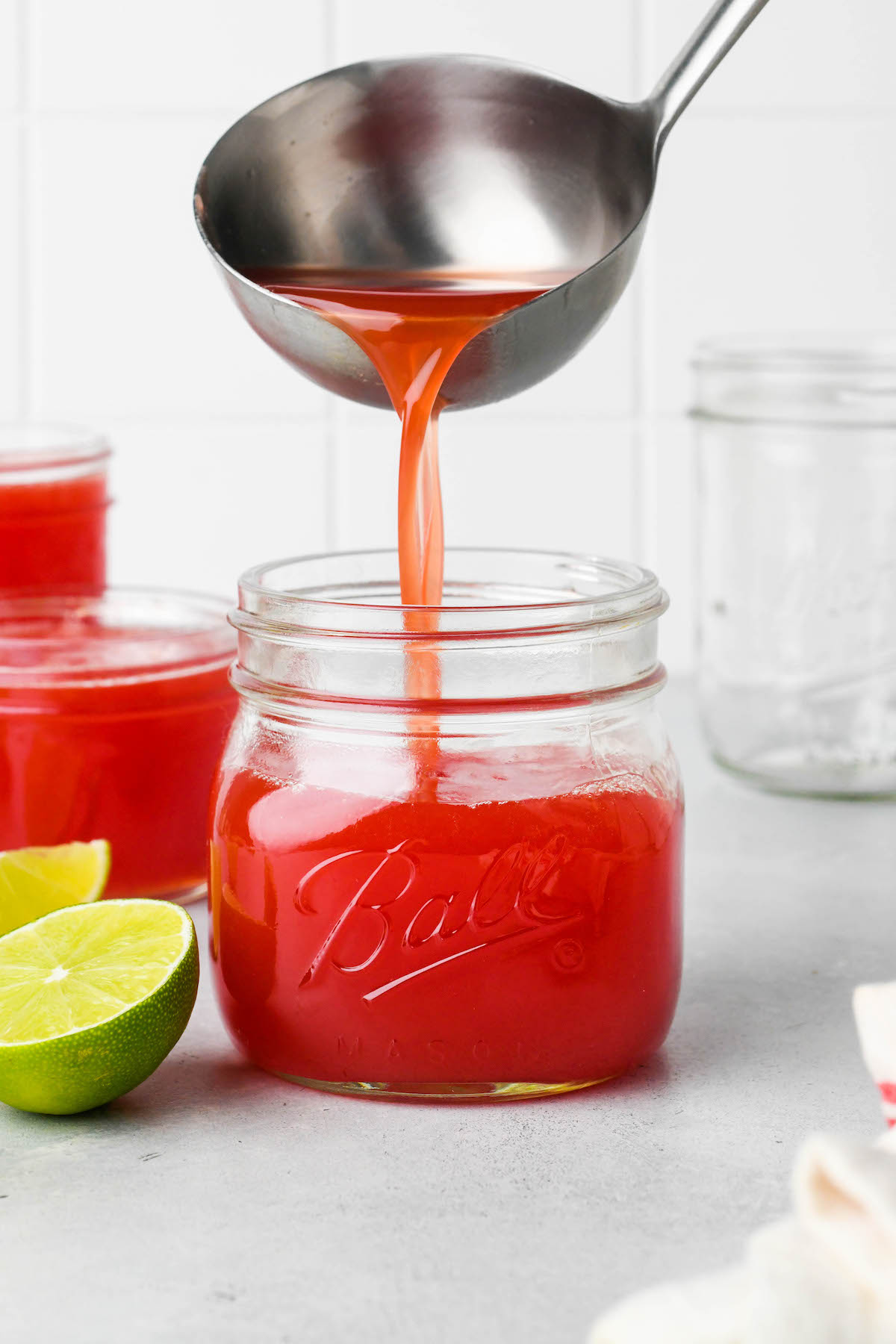
When the timer goes off, carefully ladle the hot, liquid watermelon jelly into prepared jars, leaving 1/4-inch headspace (a canning funnel is always helpful to have on hand for this stage of any canning recipe).
For jelly recipes, I like to use half-pint or pint jars—the perfect size for gifting with a cute little label and a ribbon or for keeping and bringing out whenever you or your family gets a hankering for late August produce.
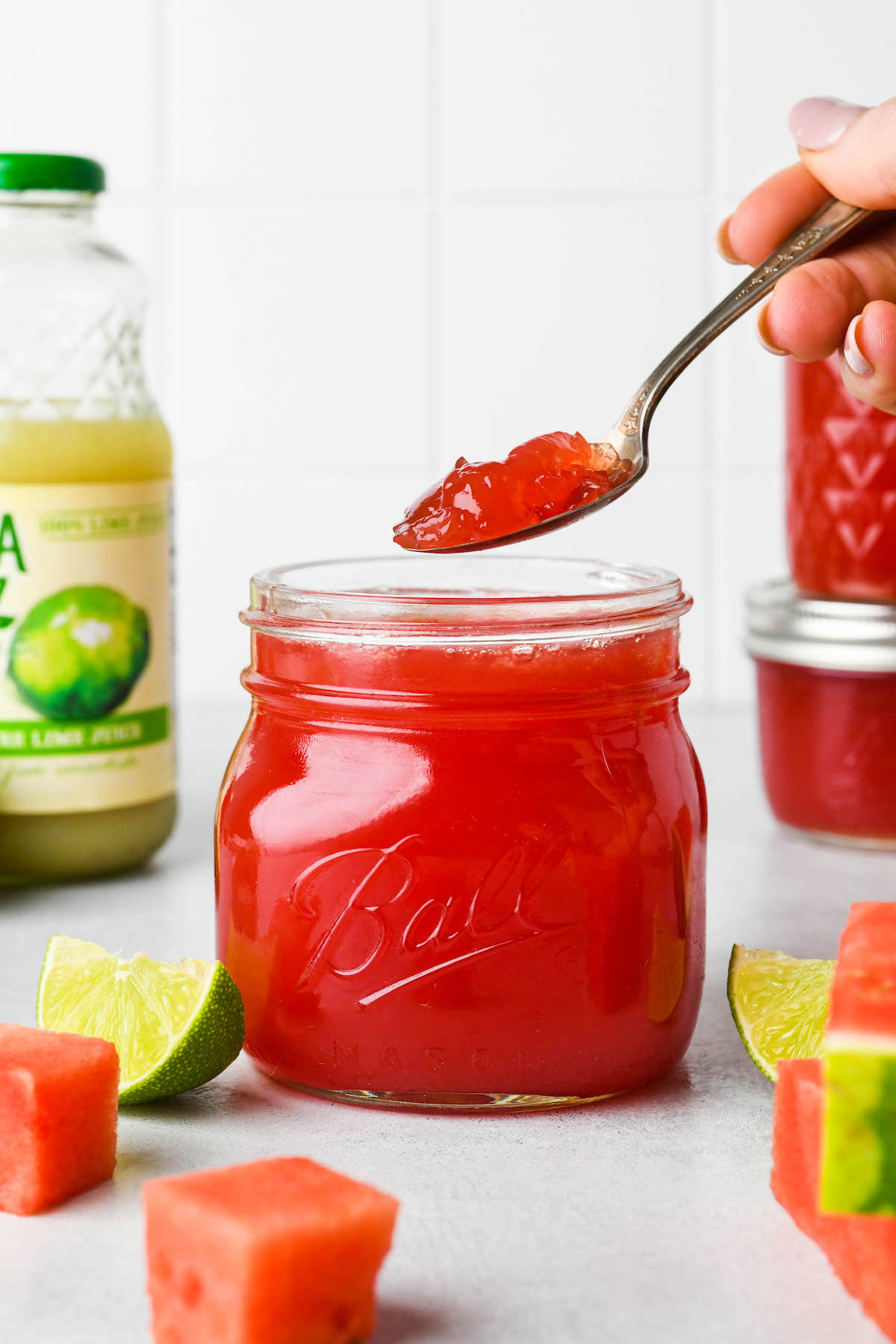
Using a clean kitchen towel, wipe down the sides and rims of the jars and apply two-piece lids until fingertip tight.
At this point, the jelly will need 24-48 hours to set. You can transfer the jars to the refrigerator without canning, in which case they should be enjoyed within three weeks. For long-term storage, simply pop the jars into a hot water bath canner and let the jelly set up after the canning process has finished.
Canning Watermelon Jelly
To can watermelon jelly, load the jars into a hot water bath canner, covering them with at least one inch of water. Bring the water back up to a boil and process the jars for 10 minutes (or 15 minutes if above 6,000 feet in elevation).
When the timer goes off, carefully remove the jars from the hot water canner using tongs and place them on a clean kitchen towel, leaving at least an inch of space between each jar.
Allow the watermelon jelly to come to room temperature, for at least 12 hours, before checking the seal of each lid. Jars with unsealed lids should be stored in the refrigerator. Jars with sealed lids can be stored in a cool, dry place away from direct sunlight for up to 18 months.
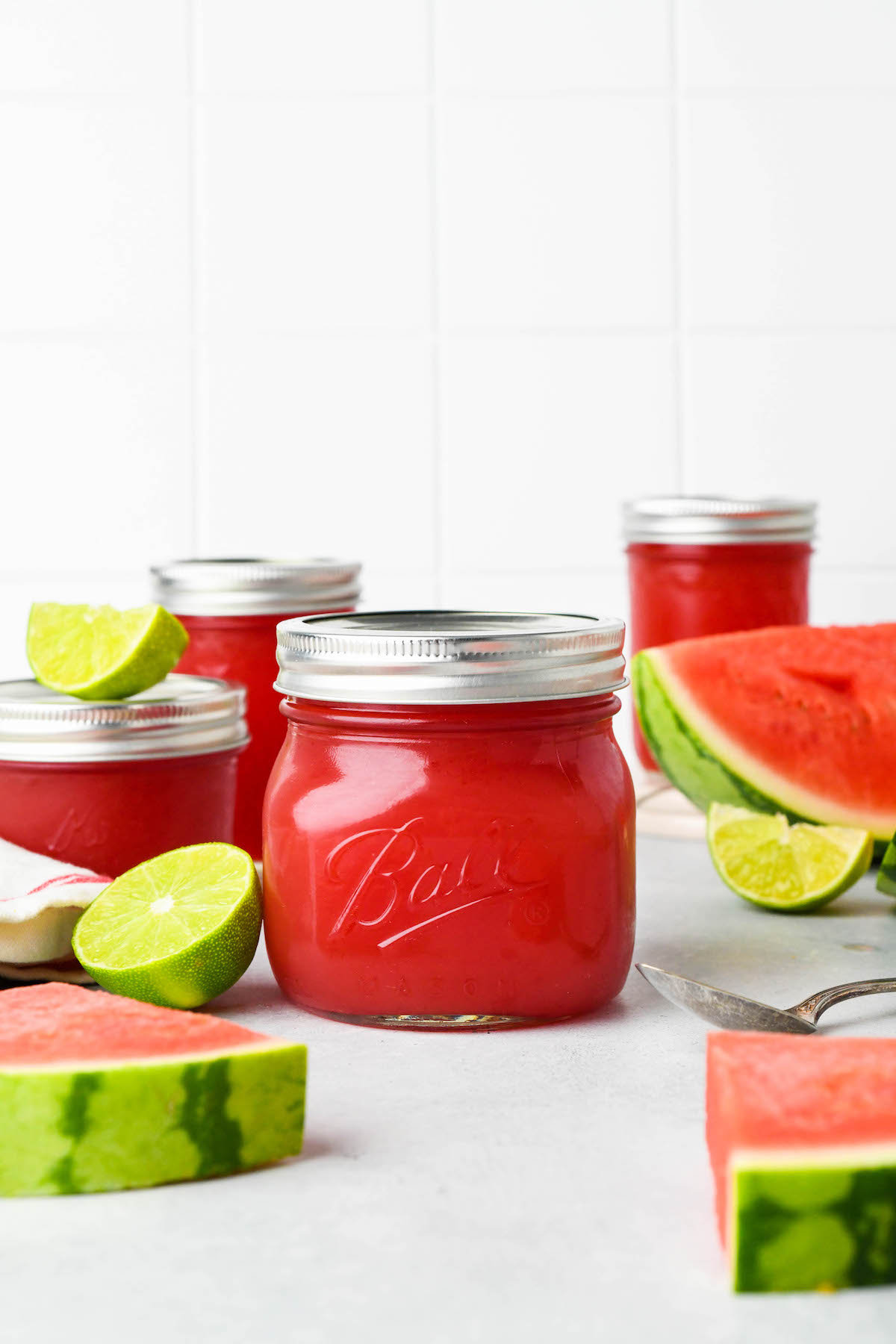
Watermelon Jelly With Pomona’s Pectin
This is a tested recipe, and the same recipe and proportions can be found in the books Put ‘Em Up by Sherri Vinton and Naturally Sweet Food in Jars by Marissa McClellan.
Both of those books use Pomona’s Pectin in their recipes, and they recommend 1 tablespoon of calcium water and 1 tablespoon Pomona’s Pectin to 4 cups of watermelon juice and 1/2 cup of bottled lemon juice.
Sherri uses 1 cup white sugar, while Marissa uses just under 2 cups agave syrup to sweeten. When using pomona’s pectin, the instructions are different, and you’ll want to follow the manufacturer’s steps using these proportions. (The calcium water is added to the juice, and the pectin is mixed in with the sugar.)
Ways to Use Watermelon Jelly
Watermelon jelly might be somewhat unusual in terms of preserves, but you can use it the same way you would use any other type of jelly (although, in all honesty, I would hesitate to make a PB&J with this particular jelly—but I’m happy to be proven wrong!).
The sweet, distinctly summery taste of this jelly means it’s just as at home on a thick slice of toast as it is spooned over yogurt, skyr, ice cream, or sorbet.
If you’re looking for other suggestions, watermelon jelly is also delicious piled onto waffles or pancakes, used to fill jelly donuts, layered into cakes, or even as the base for a fabulous watermelon cocktail (or, go alcohol-free and add a generous spoonful of watermelon jelly to seltzer water with lime juice and plenty of ice).
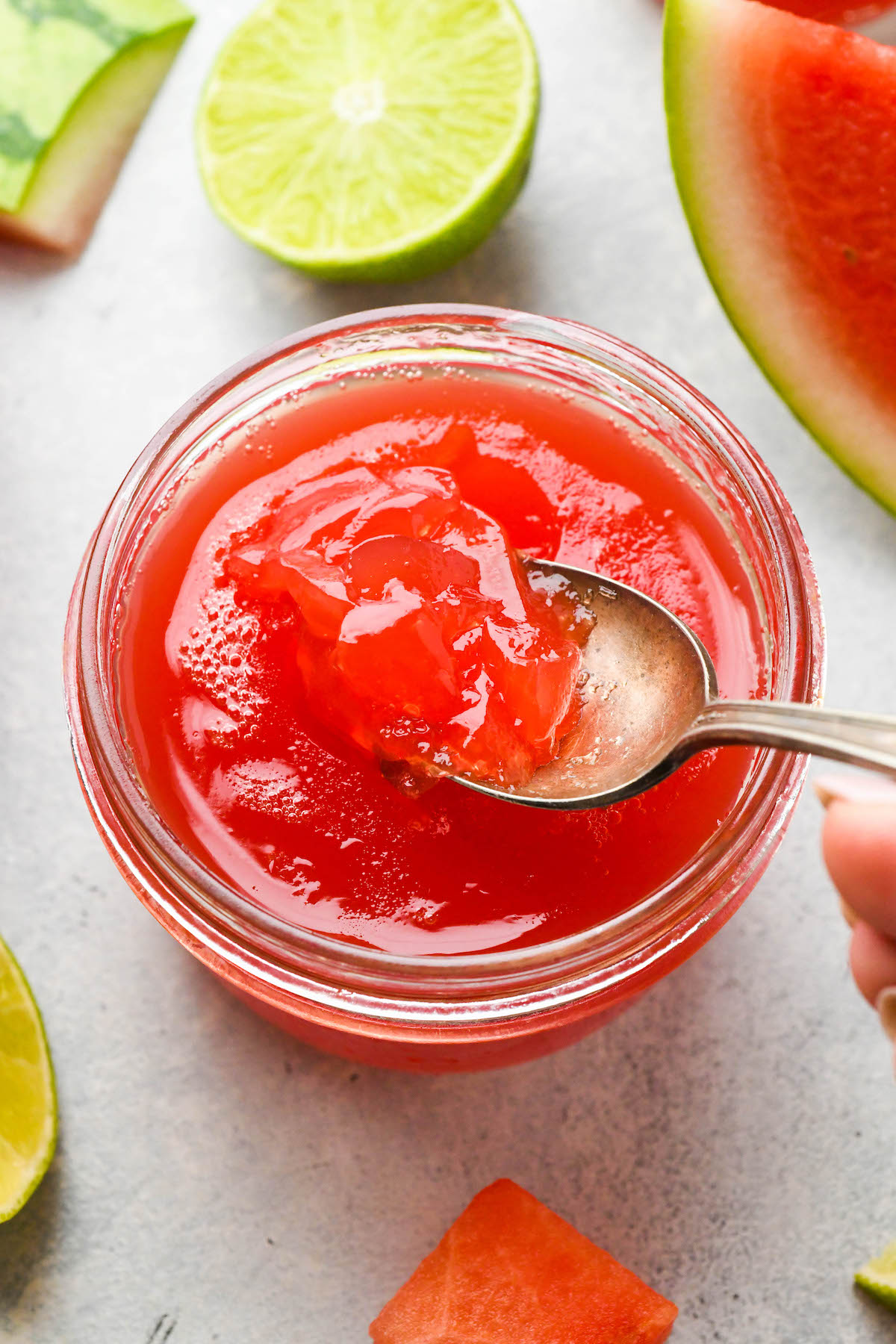
If you tried this Watermelon Jelly Recipe, or any other recipe on Creative Canning, leave a ⭐ star rating and let me know what you think in the 📝 comments below!
And make sure you stay in touch with me by following on social media!
Melon Canning Recipes
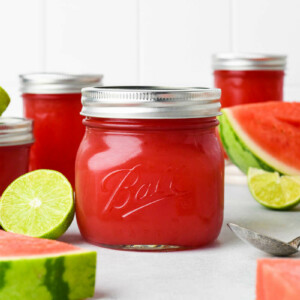
Watermelon Jelly
Equipment
Ingredients
- 6-8 cups watermelon, chopped (rind removed)
- 2-3 cups white granulated sugar
- 1/2 cup bottled lime juice
- 1 box Sure Jel Low Sugar Pectin
Instructions
- Add chopped watermelon to a blender and purée until smooth.
- Line a fine mesh sieve with a strip of folded cheesecloth or a jelly strainer bag. Pour the puréed watermelon through the sieve into a large bowl or measuring cup with lip.
- Measure out 4 cups of of watermelon juice (if doubling this recipe, be sure to double the juice amount here). Reserve leftover juice (if any) to enjoy later as a beverage.
- Transfer watermelon juice to a saucepan and bring to a boil along with the lime juice and boxed pectin (do NOT add sugar yet). Whisk to dissolve.
- Boil the juice and pectin for 1 minute.
- After 1 minute, whisk in the sugar to dissolve. Boil for 1 more minute.
- Carefully ladle the watermelon and lime juice, pectin, and sugar mixture into prepared jars, leaving 1/4-inch headspace.
- Wipe down the rims and sides of each jar with a clean kitchen towel. Apply two-piece lids until fingertip tight.
- At this point, the jelly can be transferred to the refrigerator—enjoy within 3 weeks. The jelly will take 12-24 hours to set.
- To can this watermelon jelly: Process jars in a hot water canner for 10 minutes (or 15 minutes if above 6,000 feet in elevation). Using a jar lifter, transfer jars from canner to a clean kitchen towel, leaving 1-inch of space between each jar. Let the jelly to come to room temperature before inspecting the seal of each jar—any unsealed jars should be transferred to the refrigerator. Sealed jars should be stored in a cool, dry place away from direct sunlight for up to 18 months.
Notes
Watermelon Jelly With Pomona’s Pectin
The same recipe and proportions can be found in the books Put ‘Em Up by Sherri Vinton and Naturally Sweet Food in Jars by Marissa McClellan. Both of those books use Pomona’s Pectin in their recipes, and they recommend 1 tablespoon of calcium water and 1 tablespoon of Pomona’s Pectin to 4 cups of watermelon juice and 1/2 cup of bottled lemon juice. Sherri uses 1 cup white sugar, while Marissa uses just under 2 cups agave syrup to sweeten. When using pomona’s pectin, the instructions are different, and you’ll want to follow the manufacturer’s steps using these proportions. (The calcium water is added to the juice, and the pectin is mixed in with the sugar.)Nutrition
Nutrition information is automatically calculated, so should only be used as an approximation.
Homemade Jelly
Looking for more easy homemade jelly recipes?
Summer Fruit Canning Recipes
Putting up more fruit this summer? I have plenty of fruit canning recipes…
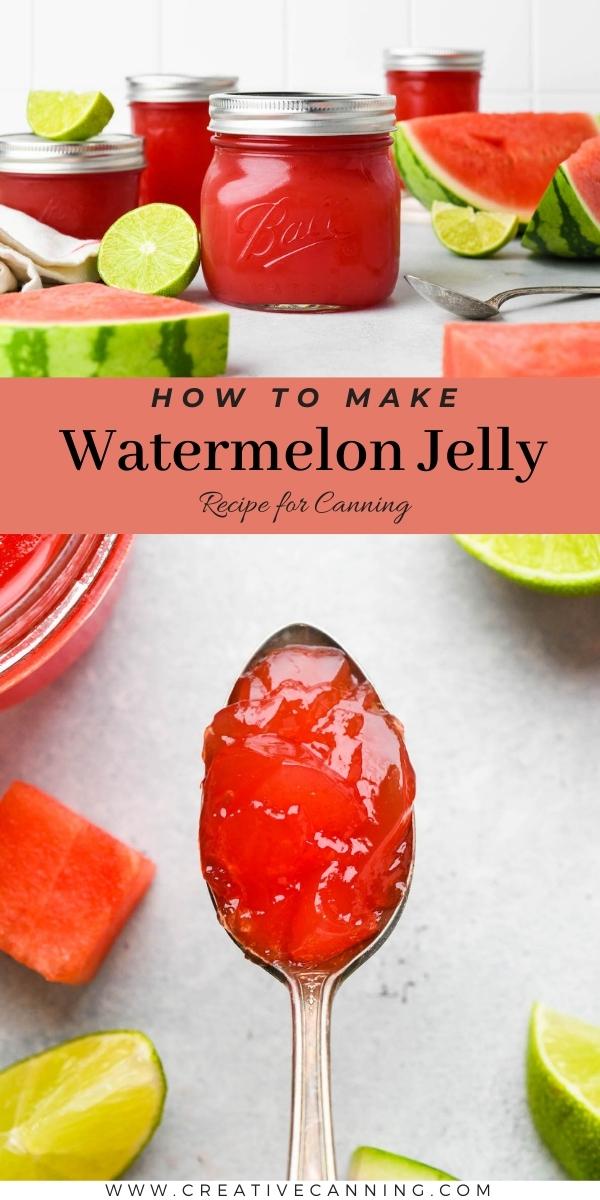
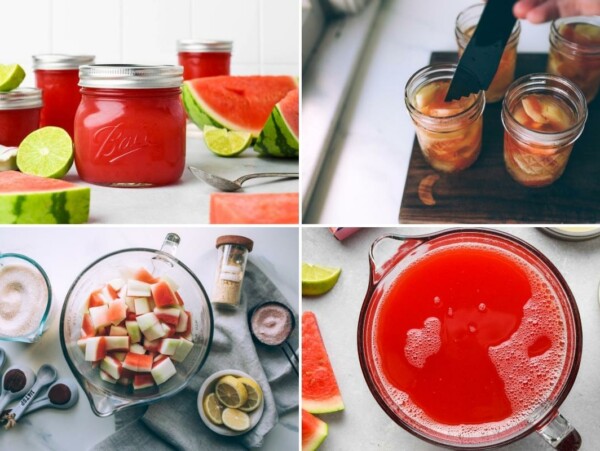
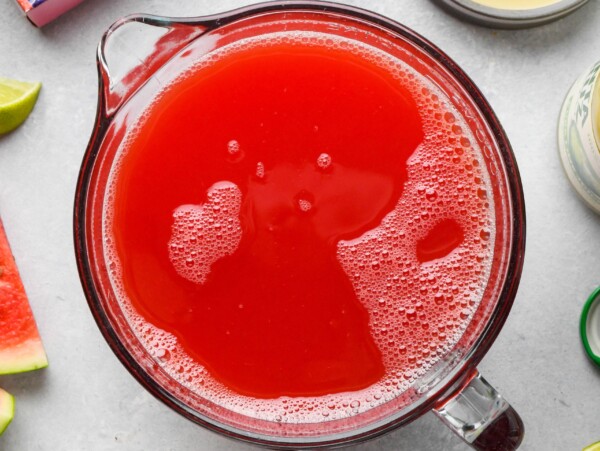
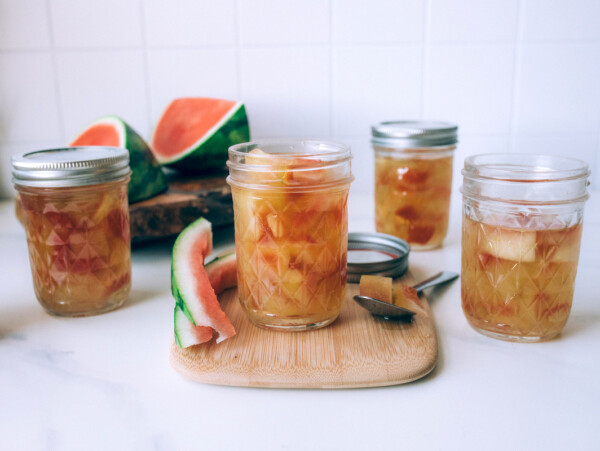
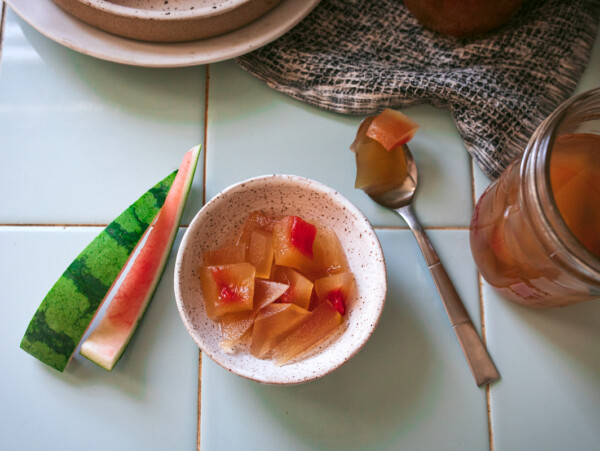
Hello Ashley! I made this recipe yesterday and absolutely LOVED the flavor but for some reason the jelly didn’t set. I followed the recipe, but tripped it, and used the same pectin you recommended. The only difference is that I used 2.5 cups of sugar instead of the 6-9 recommended because I know this low to no sugar pectin well (mostly Pomona’s brand). Is there any way I can reprocess this, and fix it without adding a bunch more sugar?
Usually pomona’s pectin is quite dependable, but you can sometimes have trouble getting set with really big batches because it doesn’t heat evenly. I’d re-make it, adding more pectin (with just a tiny amount of sugar to dilute the pomona’s) and try again. When you re-make it, do it one batch at a time and be sure to boil it 1 minute with the pectin in there. And, of course, don’t forget the calcium water, as that’s a common cause for pomona’s not setting.
If you keep having trouble, I wrote up this jelly set troubleshooting guide that has more ideas: https://creativecanning.com/troubleshooting-jelly-set/
It says 2-3 cups of sugar. Which do you recommend?
I tend to use less sugar in my recipes because I like them a bit tart, personally. If you like the sweetness level in a normal grocery store or breakfast diner jam, then go with the full sugar amount. If you find that amount cloying, and want more tart fruit flavor, go with less.
I bought a watermelon but it ended up too big for the two of us. I searched for recipes and found this one. I had the ingredients in the house and decided to try it. (I only had half the lime juice needed, so I mixed lime and lemon juices) Am I glad I did!
The recipe was easy and it tastes lovely. It reminds me of a jolly rancher candy. I will be gifting some for Christmas, with the suggestions that you gave for the ways to use it.
Thanks!
Wonderful, so glad you liked it!
I accidentally used regular sure Jell and it never set, I reprocessed it after 48 hours and same thing.. should I just dump it all and try again?
You can try to set the jelly with more sugar and liquid pectin. With liquid pectin, you add the pectin after the sugar, so it’s a good way to save jellys that didn’t set. What you’d need to do is dump the jars back into a jam pot, then add enough sugar to meet the minimum for liquid pectin (which is 7 cups sugar to 4 cups juice from your original recipe). You already have sugar in there from however much you put in, so just add a bit more to get to the crazy requirements for liquid pectin. Bring it to a boil, then add your liquid pectin and follow the instructions on the liquid pectin box.
That, or you can use it as watermelon syrup as is, or watermelon lemonade concentrate.
Those are pretty much your choices for saving it.
I made your recipe, and have waited 2 days now, and it still hasn’t set. I did everything according to the recipe, but it is still liquid. What did I do wrong. I put them in the canning bath too after making the jelly. Ugh!
Take a look at this jelly troubleshooting guide and see if that helps: https://creativecanning.com/troubleshooting-jelly-set/
My husband loves the taste of this! I was graciously given half a huge watermelon and used what I had on hand- subbed with lemon juice and regular Sure-Jell pectin with 4 cups of sugar to get the jelly to set. Made 13 half-pints total. Can’t wait to share this unique flavor with family and friends this Christmas!
So glad you like it!
I’m wondering how many pints this recipe will make?
This recipe makes about 4 to 5 half pint jars, so about 2 to 2 1/2 pints.
I’m glad you mentioned it takes up to 24-48 hours to fully set because I quickly read over the instructions and missed that part of this page and got worried an hour after preserving them in the water bath. I’m used to jam and jelly recipes setting up when the jam/jelly returns to room temp. Having reread the full article my worries were eased. I made this recipe using bottled lime juice and it tastes amazing ! Definitely would recommend and will make more again.
Wonderful, so glad you enjoyed it!
I’ve tried both of the recipes mentioned that use Pomona’s Pectin and am not happy with the texture (and we preferred the more neutral sugar over the agave nectar). It’s hard to describe but it’s just different. Perhaps it’s because the cooking time is less and the juice isn’t reduced as much?
Does this recipe made with either SureJell or Ball low sugar pectin have a similar texture to jelly made with Pomona’s Pectin or will it be more like using regular pectin (and more sugar)?
Lately I’ve used Marisa’s recipe from her blog and getting a good set with a bit less sugar (4 1/2 cups to 6 cups juice) but would love to be able to use only 1 cup sugar to 4 cups juice (instead of the 3 cups I’m currently using).
Appreciate any insight!
I also don’t use pomona’s anymore due to the texture. It’s more like gelatin than a jelly. Sure jel low sugar is not like that at all and gives you a set that’s pretty much identical to a regular jelly.
This looks amazing!! Question about using lemon juice: I canned some Meyer lemon juice myself, is that the same as using store-bought bottled lemon juice? Since it’s heated and processed by a water bath is it neutralized the same?
So the reason you use bottled lemon juice in recipes like this is that it’s a standardized pH, meaning all bottled lemon juices have the same acidity…and thus dependably lower the pH of whatever you’re canning. Lemons range in pH, and some are much more acidic than others. Regular lemons are generally more acidic than meyer lemons, so in any case you’d need more meyer lemon juice to reach the same pH, but since it’s not commertially bottled/tested then it’s hard to know the exact pH.
In theory, you could use your bottled meyer lemon juice, but the trick is you wouldn’t know how much you need to add to get a pH safe for canning. (Unless you have pH test strips.)
(You mention neutralized the same, but it’s not a sterilization thing, it’s a standard pH thing. It’s not because it’s canned (at home or commercially), it’s that it’s made so it’s exactly the same pH every time in the bottling plant.)